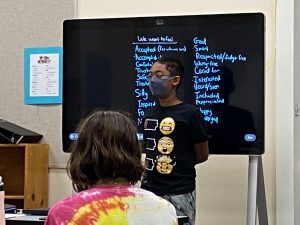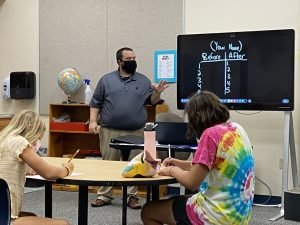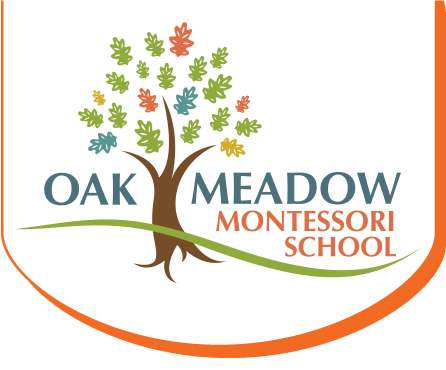Everyone these days talks about social-emotional learning (SEL) and how important it is. What does SEL mean to you?
 SEL relates to the development of social and emotional skills that support overall success in life. Some of these skills include self-awareness, being responsible, organizational skills, being engaged, good decision-making, and problem-solving. These skills are useful to both the individual student and to group work. SEL helps children reach more of their individual potential. SEL skills are also valuable in constructing healthy group dynamics. They are instrumental in creating a class culture that is respectful, caring, inclusive, and just. SEL is an important foundation in everything your child does at Oak Meadow because it supports academic learning.
SEL relates to the development of social and emotional skills that support overall success in life. Some of these skills include self-awareness, being responsible, organizational skills, being engaged, good decision-making, and problem-solving. These skills are useful to both the individual student and to group work. SEL helps children reach more of their individual potential. SEL skills are also valuable in constructing healthy group dynamics. They are instrumental in creating a class culture that is respectful, caring, inclusive, and just. SEL is an important foundation in everything your child does at Oak Meadow because it supports academic learning.
I stopped by Mr. Dauphinais’ class of Upper Elementary 6th years this week and made the following observations:
The previous week, students had created a list of words describing how they want to feel when they are at school. They reflected on this individually, and then shared their thoughts in order to compile a list that reflected everyone’s ideas. That list included:
- Respected (for who we are)
- Accomplished
- Comfortable sharing
- Trusting/trusted
- Safe
- Treated with kindness
- Silly
- Inspired
- Focused
- Good
- Smart
- Respected/Judge-free
- Worry-free
- Cared for
- Interested
- Heard/Seen
- Included
- Appreciated
- Happy
- Challenged
 Each student was then asked to create a two-column chart, putting their name at the top. The left column was marked “before” and the right column was marked “after.” From this list, individuals independently wrote down which 5 feelings were most important
Each student was then asked to create a two-column chart, putting their name at the top. The left column was marked “before” and the right column was marked “after.” From this list, individuals independently wrote down which 5 feelings were most important
“One of my goals for you,” said the teacher, “is to help you learn how to make an argument and to state your position. That’s part of fulfilling your civic responsibilities. So I want you to individually ‘make a case’ for one of your 5 words. You need to state your case in 30 seconds in front of the class. After you listen to each student make a case for 1 word, then you will write down the 5 words that are now most important to you after hearing from your classmates.”
Students volunteered to stand up, go to the front of the room, and make their case for one word. One student said, “My word is ‘judge free’ because none of us wants to be judged by the color of our skin or the specific culture we bring to the school. Instead we only want to be judged by how we act.” Then another student continued the process. “My word is ‘seen and heard’ because if I am not seen and heard and something is wrong, it will not get better.” “Motivated” was the word shared by another student. “Being motivated helps you in life. If you are motivated, nothing can stop you.”
When the student presentations ended, the teacher asked the students to fill out the “after” column on their own. “This is not the final list,” the teacher explained. “This is just another step in our process of making a smaller subset of words. What we are going to find is that some words actually fit together well with others, and that will allow us to condense the list into just those words that can define what we all agree we most want to feel at school.
This exercise was the mechanism for making a “classroom charter.” A similar process is happening, in some form, in every single classroom and program-level in our school. The classroom charter is an important way for the students to take ownership and responsibility, both for the way everyone wants to feel, and for behaviors that support, and do not obstruct, students from feeling this way at school.
Here’s how the teacher explained this to me:
“My hope with our charter process is two-fold: First, I want students to reflect on how they want to feel at school, and in doing so they naturally think about how their peers want to feel at school. Second, I want them to think about how everything they do over the course of the day (conversations, actions, body language) affect our feelings, and ultimately how these feelings affect class culture.
“The purpose of having them up in front of the room is simple: charters are collective documents, representative of the whole. I want them to be seen and heard as individuals and for them to have a tangible contribution to our process. (Admittedly, it is also great practice at tailoring one’s arguments to their audience.)
“From this vote today, a list of 8-10 words will emerge, and we will repeat the process of allowing students to make their final case and take a vote that leads us to 5 (potentially 6) terms. I will then give every person the private option to affirm the words. We will not move forward unless we are unanimous. Once we have our list, I will divide the kids into groups (one per term) to define the ‘In order to feel _________, we will…’ Finally, we need to add an article for how to resolve disputes and make amends for transgressions against the Charter.”
“From there, we will have a small committee put a document together, and the class will vote (again, unanimously) to affirm the Charter. It is my hope that by the end of next week this committee has been formed. In terms of sessions, it is my hope that 4 more sessions after today will yield us our charter.”
What I love about the classroom charter concept is that it is so concrete and specific. The students develop the charter, define how they want to feel, agree to what they will do to feel that way, and even have a way of making amends when mistakes are made. That’s a great example of SEL in action, building healthy classroom dynamics to support quality learning in the classroom. SEL is happening in every classroom at Oak Meadow.





